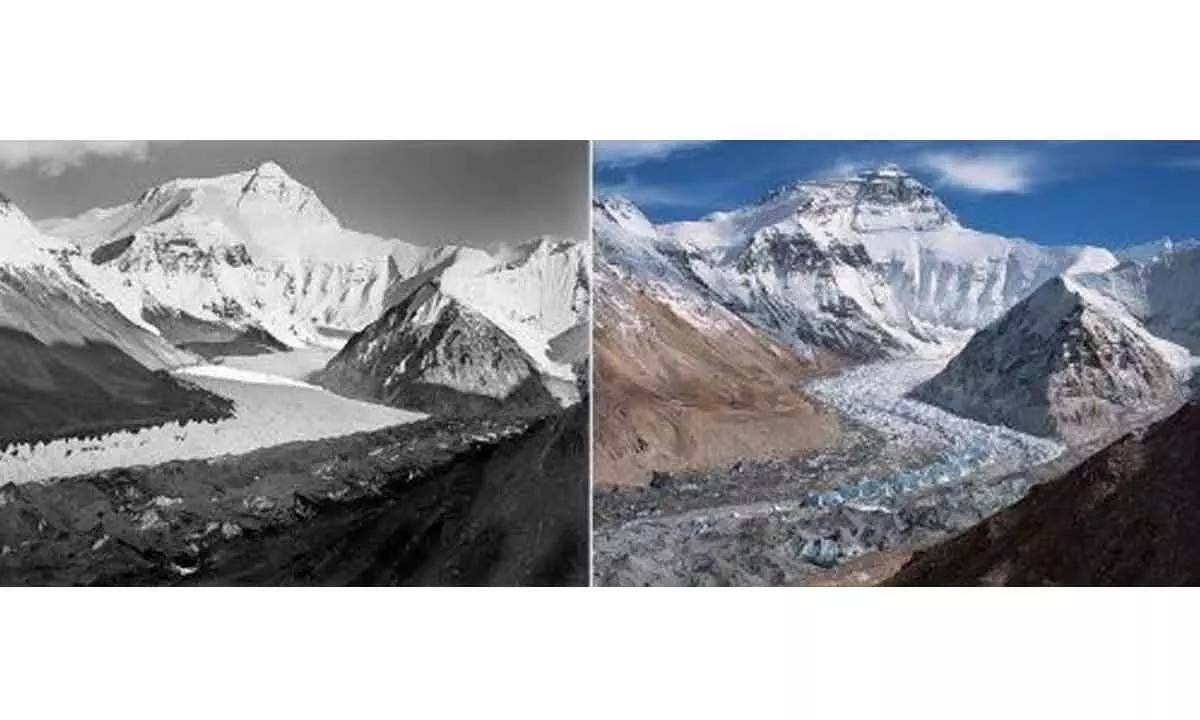Live
- Spotting Signs of an Unexpected Victory
- They always want me to win, and now I feel lucky to have been offered a story like ‘Zebra’: Satyadev Kancharana
- ‘Democracy first, humanity first’: PM Modi in Guyana's parliament on two countries' similarities
- PKL Season 11: Telugu Titans register third straight win to top standings
- Is Pollution Contributing to Your COPD?
- NASA Unveils Underwater Robots for Exploring Jupiter's Moons
- Additional Central forces arrive in violence-hit Manipur
- AR Rahman and Saira Banu’s Divorce: Legal Insights into Common Issues in Bollywood Marriages
- 82.7 pc work completed in HPCL Rajasthan Refinery area: official
- Curfew relaxation extended in 5 Manipur districts on Friday
Just In

Glacier retreat rate is controlled by climate change and the topographic setting and morphology of the glacier. A comparative study published in the journal 'Sustainability' also confirms the possible influence of factors such as snout geometry, glacier size, elevation range, slope, aspect, debris cover, as well as the presence of supra and proglacial lakes other than the climate in the heterogeneous glacial dynamics and underlined the need to include these in glacial studies
New Delhi: A scientific study has discovered that the glacier retreat rate is controlled by climate change, the topographic setting and morphology of the glacier. A team of scientists from Wadia Institute of Himalayan Geology (WIHG), Dehradun, Uttarakhand, India (an autonomous institute under department of science and technology) quantitatively evaluated the influence of the debris cover on the loss of ice mass in summer (summer ablation) and on terminus recession of glaciers.
Hurricanes, floods, glacier melting and other natural disasters inflicted $270 billion in damage worldwide in 2022, less than the "extremely costly 2021" with $320 billion, a German reinsure said in a report. "2022 joins the recent run of years with high losses," the report by Munich Re said. The costliest natural disaster in 2022 was Hurricane Ian in the US, which caused losses of around $100 billion, Xinhua news agency cited the report as saying. "Climate change is taking an increasing toll," Thomas Blunck, member of the Board of Management of Munich Re, said in a statement. The natural disaster figures for 2022 were dominated by events that were more intense or occurred more frequently, he added.
Manish Mehta and his team studied two glaciers with different characteristics -- the Pensilungpa Glacier (PG) in Suru River and the Durung-Drung Glacier (DDG) in Doda River basins of Zanskar in the Leh district of Ladakh for a comparative study of glacier fluctuations between 1971 and 2019. While a thick debris cover characterizes the PG, the DDG has a thin debris cover, and their comparative analysis helped them trace the influence of various factors on the mass balance process.
They found that the glacier retreat rate is controlled by climate change and the topographic setting and morphology of the glacier. Their comparative study published in the journal Sustainability also confirms the possible influence of factors such as snout geometry, glacier size, elevation range, slope, aspect, debris cover, as well as the presence of supra and proglacial lakes other than the climate in the heterogeneous glacial dynamics and underlined the need to include these in glacial studies.
As rising temperatures shrink glaciers, melt water can collect to form lakes nearby which could put about 15 million people in high mountains at risk of glacial lake outburst floods, according to a study on Wednesday. These lakes are a significant natural hazard for people living downstream, because outburst floods can occur suddenly with the failure of a natural dam, said a new research published in Nature by New Zealand and international researchers. The study has found that those living in High Mountains Asia and the Andes are the most exposed to this danger, and the areas with dense population and less resources to cope are most at risk, Xinhua news agency reported.
Glacial lake outburst floods can happen without warning when a natural dam fails, which requires urgent attention to minimise future loss of life, said University of Canterbury School of Earth and Environment Senior Lecturer, Thomas Robinson. Since 1990 the number and size of glacial lakes has grown rapidly and currently 15 million people globally are exposed to impacts from potential glacial lake outburst floods, he said. "People in High Mountains Asia are most exposed and on average live closest to glacial lakes, with about 1 million people living within 10 km of a glacial lake," he added. Robinson said it is important to work closely with the exposed communities identified in the study to prevent major disasters.
Change in debris cover plays a critical role in the glacier surface lowering, shrinkage, retreat, and mass balance, according to a recent study. Therefore, these factors need to be accounted for in future studies for a complete understanding of the observed glacier changes and responses.
Despite the importance of the Himalayan glaciation, the knowledge of the glacial dynamics and the factors that influence these dynamics is scanty. Recent studies of Himalayan glaciers indicate wide variability in retreat rate and mass balance in different sectors of the mountain range, primarily linked to the topography and climate of the region. However, variable retreat rates of glaciers and inadequate supporting field data (e.g., mass balance, ice thickness, velocity, etc.) of the Himalayan glaciers make it challenging to develop a coherent picture of climate change impact.
One of the significant characteristics of the Himalayan glaciers is that the glaciers are mainly debris-covered and have been receding since the end of the Little Ice Age. The supraglacial debris on the surface of glaciers is commonly found to have significant control over the rate of loss of mass of ice due to sun, wind, or rain (ablation). It has been observed that the thickness of supraglacial debris significantly alters the glacier response to climate forcing. (IANS)

© 2024 Hyderabad Media House Limited/The Hans India. All rights reserved. Powered by hocalwire.com







